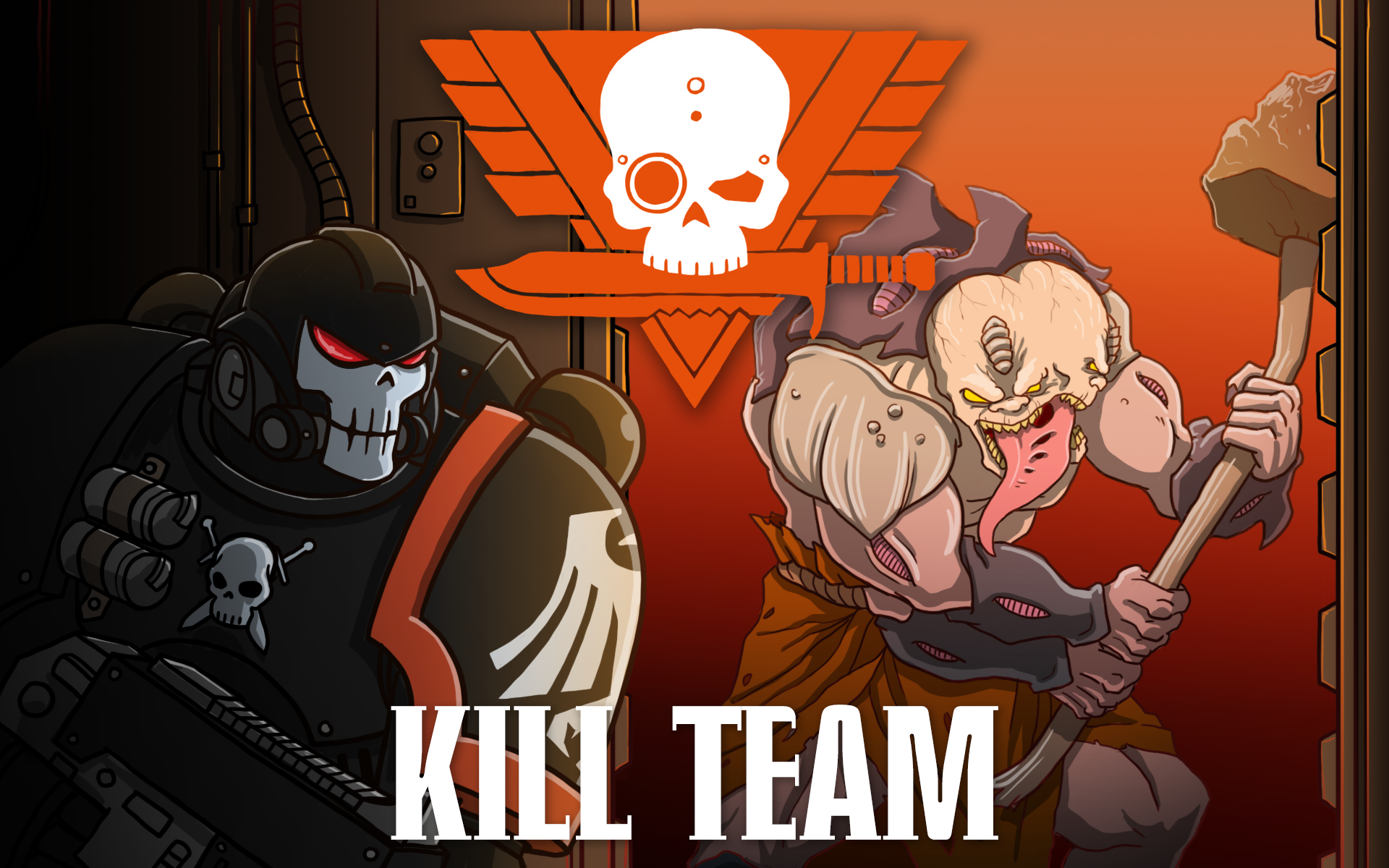The upcoming release of Kill Team: Hivestorm – which goes up for pre-orders this Saturday – also represents a new edition for Kill Team, marking the third version of Kill Team as its own standalone game. But as we’ve worked through the previews and started on our review content, one major question has surfaced: What do we call this edition? Is it Kill Team 2024? Kill Team 3.0? Sixth Edition?
Wait, what was that last one?
You heard me. This week we’re taking a break from the usual competitive content to talk about the history of Kill Team, how it has evolved over the years, and where we’re currently at. And by the end we’ll hopefully be able to settle on a name for this new edition of the game.
The Prototype: 40K in 40 Minutes
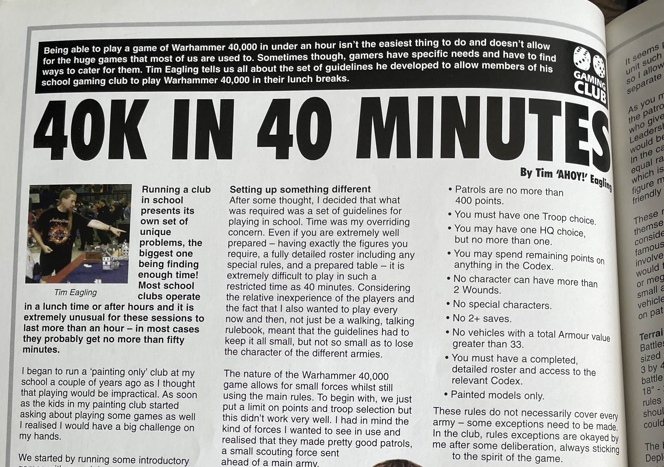
Kill Team started life as 40K in 40 Minutes, with rules originally published in White Dwarf #274 (UK numbering) in October 2002. At the time, Tim Eagling had been looking for a way to play games in under an hour, in order to meet the demands of playing games at his school club. This original set of rules represented smaller scouting forces and patrols, sent ahead of the main army. The rules here limited players to 400 total points per side, with one compulsory HQ and Troop choice each, and some restrictions around things like keeping vehicle armor values low and preventing models with 3+ wounds or a 2+ save. If this sounds a lot like Combat Patrol, well, it’s also the genesis of Combat Patrol, though that game mode wouldn’t really see a full revival until tenth edition.
These early rules depended heavily on the rules for third edition Warhammer 40k, and beyond those guidelines above really just told players to set up on a 36″x48″ table and put an 18″-24″ gap between the two armies at deployment. In addition to the rules shown above, Patrols have to start taking Leadership tests similar to Necromunda when they hit 50% casualties, and if they fail they bottle out and flee the table.
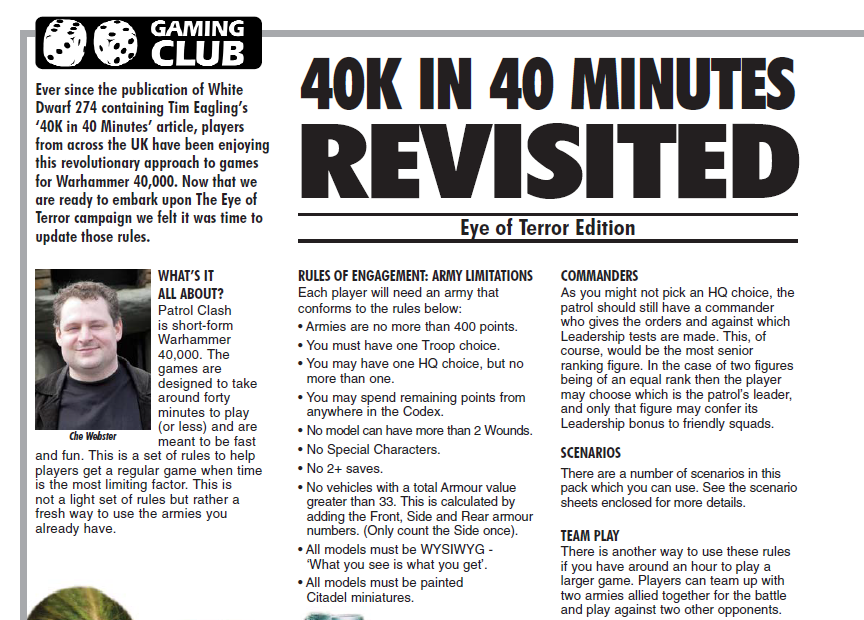
These rules would see an update just under year later in White Dwarf #284 (UK numbering), during the waning days of the Eye of Terror campaign. At this point, the format was renamed Patrol Clash, and would carry on the same rules for army construction as the original 40k in 40 minutes. These updated rules would add rules for allies and having 2v2 games (which seems like it defeats the purpose but you could probably make it work if your players were experienced), as well as three new scenarios.
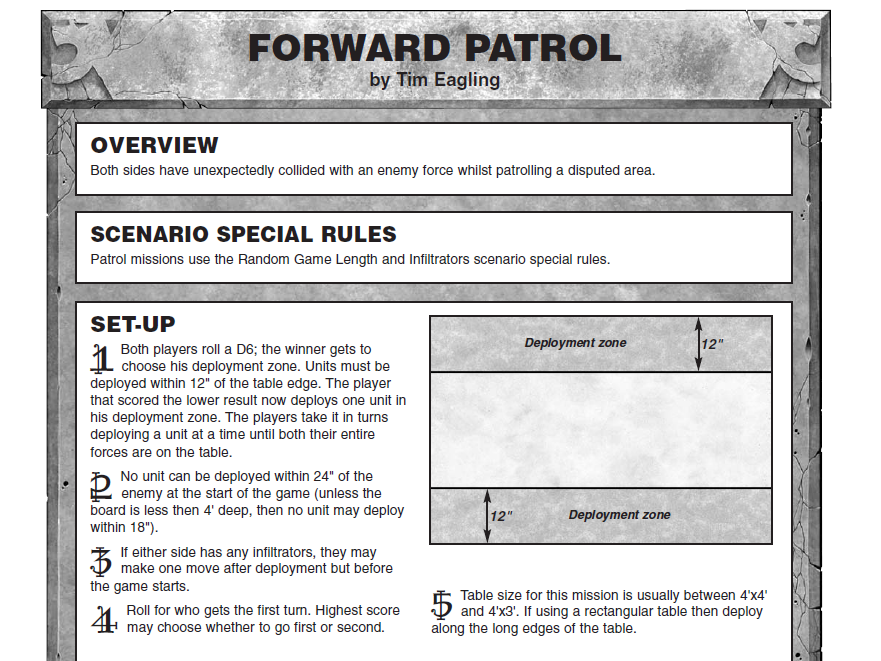
While the issue suggests using the Recon, Cleanse, and Patrol missions from the third edition rulebook, there are three new options here, written by different authors – Forward Patrol, The Camp, and Search and Retrieve. The Camp is of particular interest here – the idea of infiltrating a camp guarded by sentries who can raise an alarm would eventually become the basis for Kill Team missions in White Dwarf fourth edition, with more detailed rules for how to handle sentries.
The First Edition of Kill-Team: Warhammer 40k 4th Edition
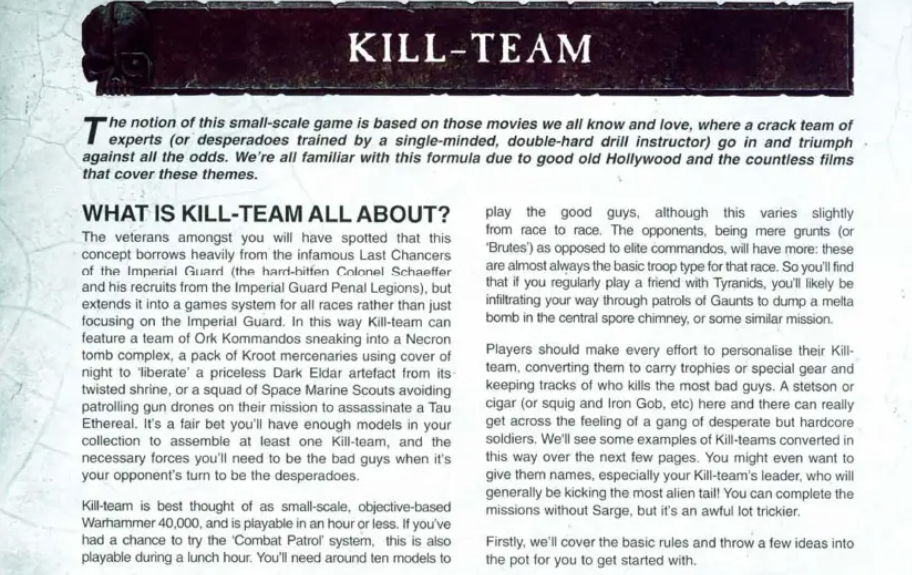
Kill Team’s proper first edition wouldn’t see print until the release of Warhammer 40,000’s fourth edition in August, 2004. These rules were included in the fourth edition rulebook as an additional, faster way to player Warhammer 40,000 – but also with a more cinematic flair. In this format, modeled heavily after The Camp mission introduced to 40k in 40 minutes the year prior, players were split into two teams: Kill Teams (the good guys), and Brute Squads (the bad guys). Brute Squad players set up the table and place a central objective, then sets up sentries in groups of 3 near said objective. These have to be deployed apart and will wander the table on patrol. Players roll off to determine who gets to move the Brute Squads, and if the Kill Team player wins, they get to push the Brute Squads in a direction of their choosing. This becomes more difficult as alarms are raised, and the Brute Squad gets to add their Klaxon Counters to their roll.
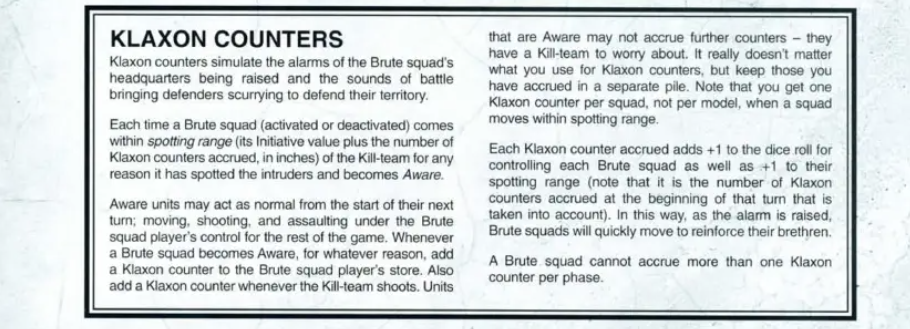
On that note – as the Kill Team players become spotted, they raise Klaxon Counters, which makes it easier for the Brute Squad to take action. By the end of the game, a Kill Team is certain to be facing the full might of the Brute Squad, so it’s important they pick off as many brutes as possible before that Klaxon count gets too high.
Why Is This First Edition?
As tempting as it would be to call 40k in 40 minutes or Patrol Clash the first edition of Kill Team, this is really where it starts, and not just because of the name – the Fourth Edition rules for Kill Team limit a player to a single squad, with a maximum of 160 points to spend. The catch is they can choose individual models from different units and outfit them with whatever wargear they see fit, so long as all of the Kill Team operatives come from the same codex. There are still restrictions on their gear – you can’t take 2+ saves, psychic powers, or bikes and jetbikes (3rd and 4th edition treated these as wargear items) – and some options will improve the strength of the Brute Squad you go up against.
This version of mix-and-match roster construction would become a staple of the game moving forward, and set the tone for the game’s squad-based tactics. Most notably, this marks the jump from units moving as squads in 40k to moving as individual models, dramatically scaling down the game to focus on individual specialists looking to evade detection and accomplish their mission.

The Kill Team rules in the Core Rulebook for fourth edition offered six different Kill Team missions, with goals ranging from Assassinating an enemy leader to simple Reconnaissance. There was also a Last Stand mission in which the roles were reversed, and Kill Teams start on a central objective while the Brute Squad player attempts to destroy them, starting the game with one Klaxon counter.
This version of the game was pretty popular – as a fixture in the main rulebook it gave players a great starting point for building smaller armies, though the need to build custom teams from different units definitely encourages buying lots of boxes for a single model from each, a problem which would persist in later editions of the game. I remember playing several times, and it made for a good introductory game for friends at the time. That said, it had its warts – playing as the brute squad was always a little lame, as it felt like only one player was really playing the game and the other was acting more as a GM or adversary. While an interesting note for playing cinematic games, this ultimately was something the game would scrap in later editions.
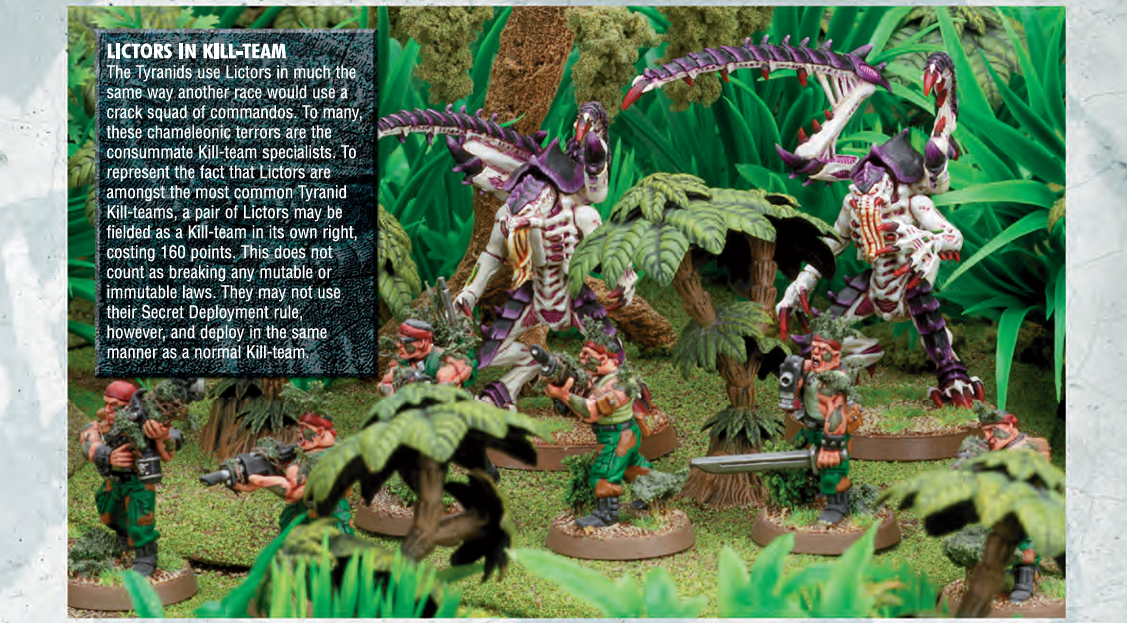
Kill Team’s first edition would receive occasional updates through White Dwarf. Issue number 307 in July 2005, which introduced new rules for Tyranid Kill Teams, was the first of these, with new scenarios and some additional rules for running Tyranids in the format. Tyranids could more freely build their teams from different units and had these rules gave them access to special mutations and special abilities to make up for the fact that Tyranids just generally didn’t have wargear the same as other factions. This would allow players to spend points on upgrades like Acid Blood and they had a number of Brute Squad upgrades as well, such as Brood Telepathy to increase the benefits received from Klaxon counters.
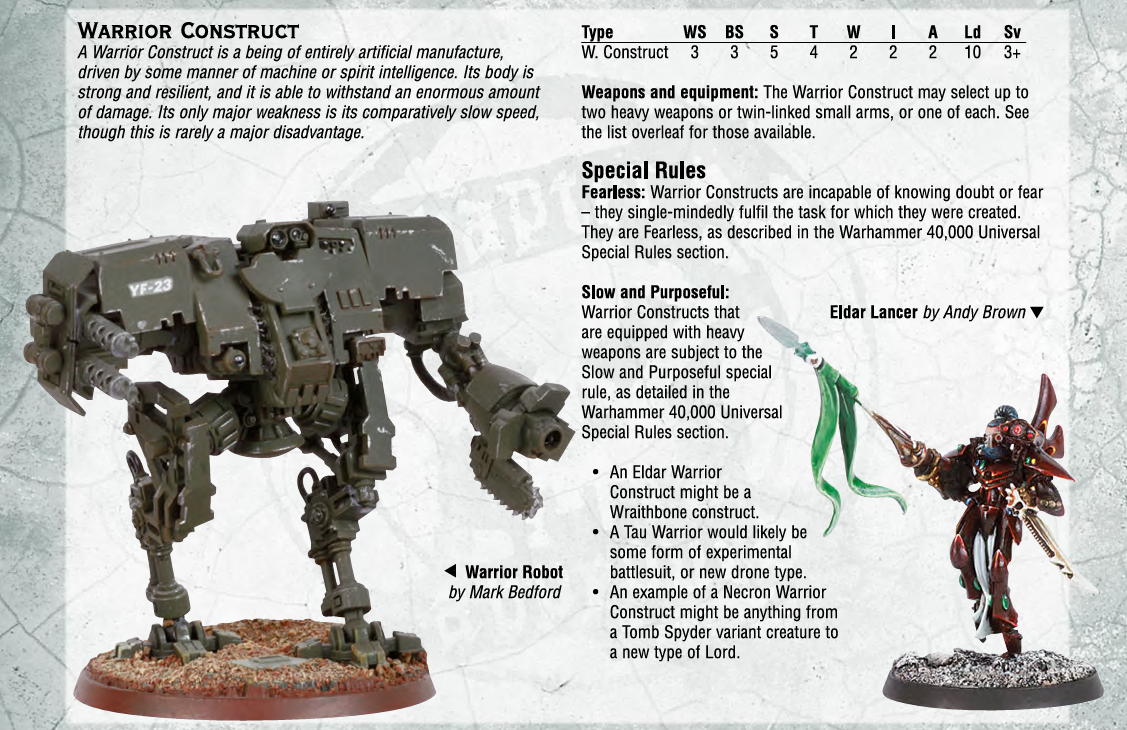
Issue 310 in October 2005 introduced rules for running a Nemesis – a really large and threatening type of bad guy in Kill Team which starts the game automatically aware of the team. The Nemesis replaces a number of Brute squads and comes in several varieties ranging from Mutant Monstrosities to Daemonhosts to massive robots, these had different traits and rules and could be taken by different factions. These are some of the coolest rules White Dwarf has ever released and there are some incredible ideas in there for conversions and modeling – one of the few reasons to check out the Warhammer Vault.
White Dwarf #312 (December 2005) added rules for battles on Armageddon, specifically a new mission around Black Templars sneaking into an Ork-held pumping station to destroy two tainted water ranks. This particular mission ran similar to Sabotage, but with a couple of twists.
Fifth Edition Warhammer 40,000
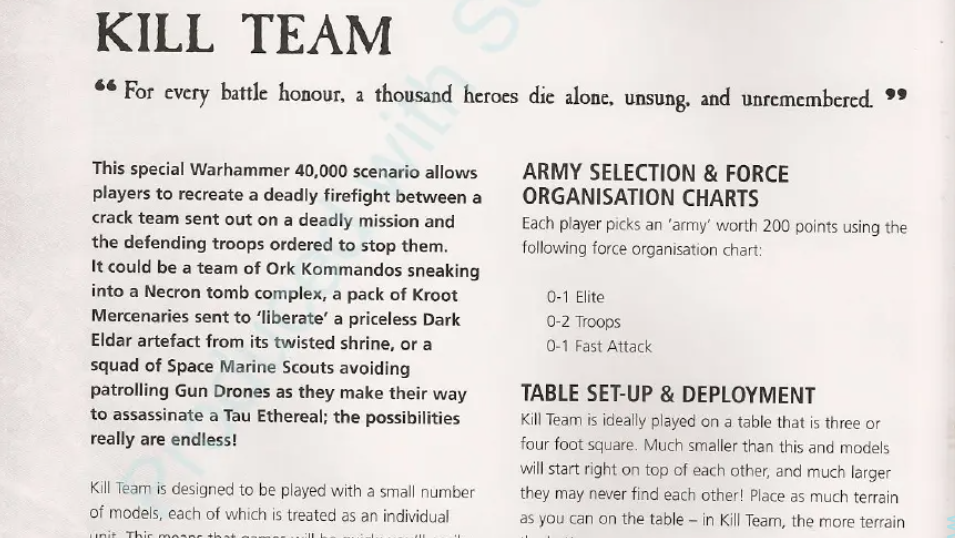
Kill Team would end up on the cutting room floor in fifth edition, stripped out of the Core Rulebook when it published in July, 2008. Fifth edition would instead focus more on Campaign play (the “Road to Glory” rules), and the supplements which were being released toward the end of fourth edition, such as Cities of Death and Apocalypse. Kill Team wouldn’t see official rules again for nearly a decade.
There was, however, one specific book which addressed Kill Team in fifth edition: The Battle Missions expansion book, published in 2010, contained 33 missions for players, with three each for the game’s ten major factions and three “special” missions in the mix. Of these three special missions, the best and most notable was Kill Team, a mission for playing with two 200-point armies consisting of a leader and up to three units. From these units players choose three models to be Specialists, each of which can take a single, different, universal special rule to mark their ability. Specialists are a core part of Kill Team and would show up again in every edition moving forward.
This version of the Kill Team rules did away with the Brute Squads of 4th edition, changing the game to one where two elite squads face off. As teams whittle each other down, they start taking Leadership tests which become progressively more difficult, until one team dies or flees the battlefield. This ultimately improves the game play, making it feel more like a small game of 40k between two fully active participants, but does admittedly kill some of the game’s cinematic feel.
Why This Isn’t Second Edition
Although this mission marks the introduction of specialists, this is a far cry from a full edition of Kill Team – it’s literally just one mission, designed to be played with a couple of small armies in a short time, built as a fun nod to the Fourth Edition game mode. When I was writing this article I didn’t even have this on my list of releases, and was surprised to discover it existed. So while it’s out there, this is not the second edition of Kill Team. Instead, that nod goes to the booklet released three years later.
The Warhammer 40,000: Sixth Edition Update

After five years without an update, Games Workshop would publish an updated set of the Kill Team rules a year into Warhammer 40,000’s sixth edition. These rules received a digital PDF release through Black Library – something that Games Workshop had started doing in sixth edition before abandoning the process in ninth edition.

These rules were very similar to those listed in the fifth edition Battle Missions book – Players have 200 points to spend on their team, choosing units from a single Codex or Supplement, with a limit of 0-2 Troops, 0-1 Elites, and 0-1 Fast Attack choice, none of which could be Flyers, Vehicles with a total of more than 33 armor values, 4+ wounds/hull points, or any models with a 2+ Armour save. At least four of your models have to be non-vehicles, and one of those gets to be your Leader while the other three become Specialists.
Why Is This Second Edition?
The big difference between this sixth edition Kill Team supplement and the Fifth Edition mission is that this release is more than two pages, but also that it has its own rules and tables. Rather than choosing a universal special rule for your specialists, there are now a series of tables for each role: Combat Specialists, Weapon Specialists, Dirty Fighter Specialists, Indomitable Specialists, and Guerilla Specialists give you a wide variety of options – each has six different traits you can pick from – and while a number of those do just give you a specific Universal Special Rule, many are more involved than that.
In addition to the specialists, this release of Kill Team also includes six missions, each with different objectives, special rules, and victory conditions. Like the fifth edition version in Battle Missions, this version of Kill Team acts as more of a midway point between Kill Team and Combat Patrol, featuring small forces – possibly with vehicles – taking on covert missions and duking it out on smaller battlefields. This is the version of the game that Battle Missions was gesturing toward, and has been more thought-out and fleshed out.
That said, this version of the game had its warts; vehicles just don’t feel great in the format, and the realities of armour values meant that if your team didn’t plan appropriately you might find yourself in combat with a Dreadnought you had absolutely no means of harming. Additionally, the restriction on 2+ saves seemed misguided – why exactly couldn’t Terminators be on kill teams? They were much more capable covert operatives than say, a tank, and the game’s lore was rife with stories of Terminator kill teams teleporting aboard space hulks to kill enemy command or take the bridge.
Heralds of Ruin

If there was ever a time Games Workshop faced real competition it was during sixth and seventh edition, and while the full scope of that is the topic for another article, it’s worth noting that this extended to Kill Team. Shortly after the release of sixth edition, a group called Heralds of Ruin released their own homebrew rules for Kill Team. This version of the rules acted more as a fully standalone game, with new stat lines, equipment, and rules for each faction. The Heralds of Ruin rules allowed players to build teams of up to 250 points, though again, using custom points and armories for each faction.
One thing which Heralds of Ruin did add to their rules was an Injury mechanic – borrowing the concept from Necromunda, when a model lost its last wound, the attacking player would roll a D6 to determine how badly they were injured. On a 5-6 they’d be out of action, on a 3-4 they’d be stunned (taking two turns to get up), and on a 1-2 they’d merely be Knocked down, and have to get up the following turn. This mechanic allowed the game’s plethora of 1-wound models to feel just a little more durable, sticking around with a chance to get back up and get in the fight – something which had become more necessary as the game became more deadly.
The Heralds of Ruin version of Kill Team had a lot going for it; it was fun, and thanks to custom army lists, it felt much more balanced and well thought-out than the sixth edition version of Kill Team. It was also, by all accounts, a much more popular version of Kill Team than the official rules – beyond just the lower cost (free), the official rules were not well marketed or widely distributed, and most players weren’t even aware there was an official Kill Team release during sixth edition.
Kill Team (2016)
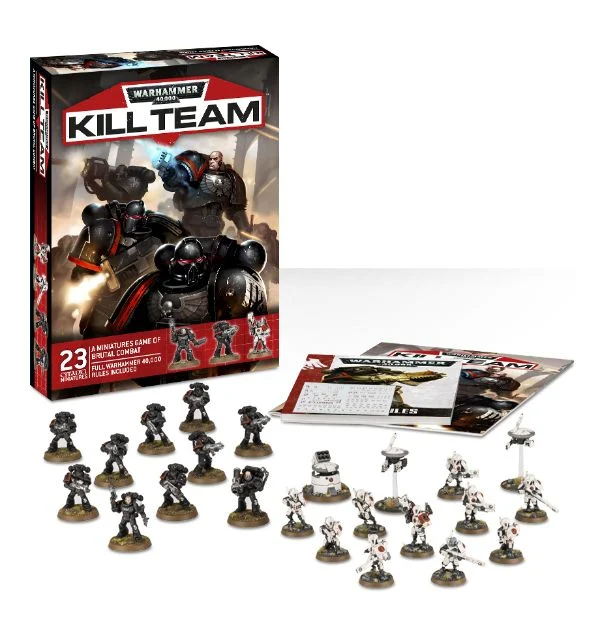
Sixth edition Warhammer 40,000 was the shortest-lived edition in the game’s history, replaced by seventh edition only two years later, in May 2014. Seventh edition updated a number of the game’s rules, added new psychic disciplines, and introduced formations to the game, but allowed players to keep the same Codexes. Seventh edition also saw the advancement of the larger 40k narrative in several areas – Campaign books like Shield of Baal, War Zone Fenris, and War Zone Damocles all pushed the game’s larger story forward, and the latter of these would see a number of new releases. One of those tie-in releases was an updated print version of Kill Team, packaged in a boxed set with a small version of the 7th edition core rules, a unit of tactical marines, and a unit of T’au Fire Warriors.
These rules were, in most respects, a prettier, updated version of the sixth edition rules. Leaders retained their six possible traits, but the list of skills opened way up for team specialists, with each having a choice between a set of Universal Special Rules and some custom rules – for example, the Combat Specialist could choose one of Counter-Attack, Hammer of Wrath, Rage, Furious Charge, or Hatred, or could opt for a rule like Warrior Adept, improving their WS by 1. Kill Teams were still built from 200 points of units, chosen from a Force Org chart with 0-2 Troops, 0-1 Elites, and 0-1 Fast Attack, and still had the same restrictions around wounds, armour values, saves, and non-vehicle models.
You may have noticed that a unit of Fire Warriors is no match for a full marine Tactical Squad, and these two units had different costs – 190 points for the tac marines vs. 134 for the Fire Warriors. Not a ton of thought was put into balancing this box, and that’s because the goal here is to sell you $90 of older models for $65. It’s a fine deal, and was OK for introducing someone to the game, but it’s not intended to be a balanced game and never received any updates.
Why Is This Third Edition?
It’s the first standalone Kill Team boxed game, and it stands as a clear improvement on the rules released in Sixth edition Warhammer 40,000. It’s not amazing, and it never saw any support, but it was fun enough and it helped start the process of Kill Team receiving its own boxed releases. We’d get one more Kill Team-adjacent release the following year before the game would finally start to break off on its own.
Shadow War: Armageddon
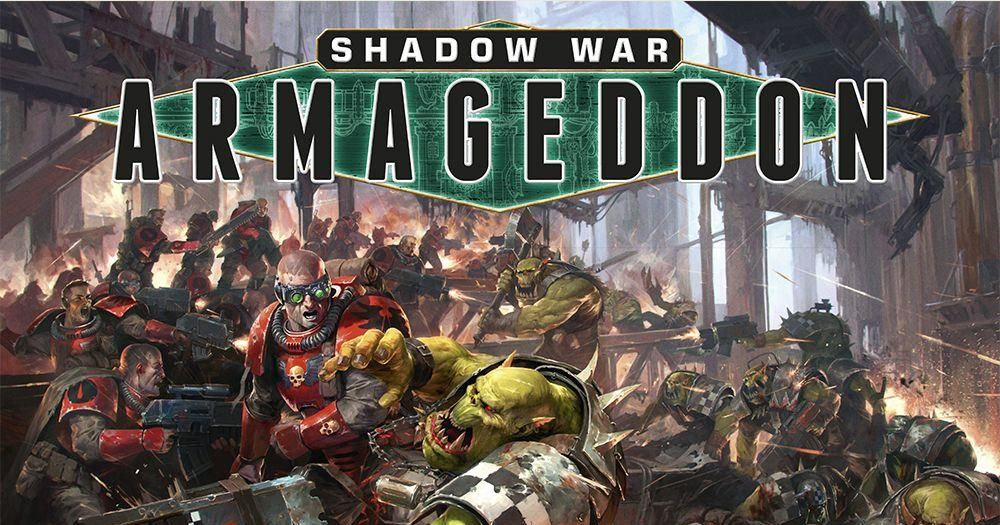
In early 2017, Games Workshop released Shadow War: Armageddon, a boxed set featuring two teams – Space Marine Scouts and Ork Boyz – along with a massive amount of brand new Sector Mechanicus terrain and rules for playing skirmish games using small, dedicated kill teams. These rules were largely updated versions of the classic second edition Necromunda rules, using similar rules for range, melee combat, and injuries. Teams would consist of anywhere from five to twenty models and could purchase custom wargear like scopes, camo cloaks, and laser sights.
Shadow War operatives had custom stat lines built to look like older Necromunda – movement values returned after being gone for third through seventh edition – and allowed for some limited progression, with teams having a mix of Leaders, Troopers, New Recruits, and Specialists. Teams also had access to Special Operatives for some missions, such as Terminators or Jump troops, to help accomplish certain missions.
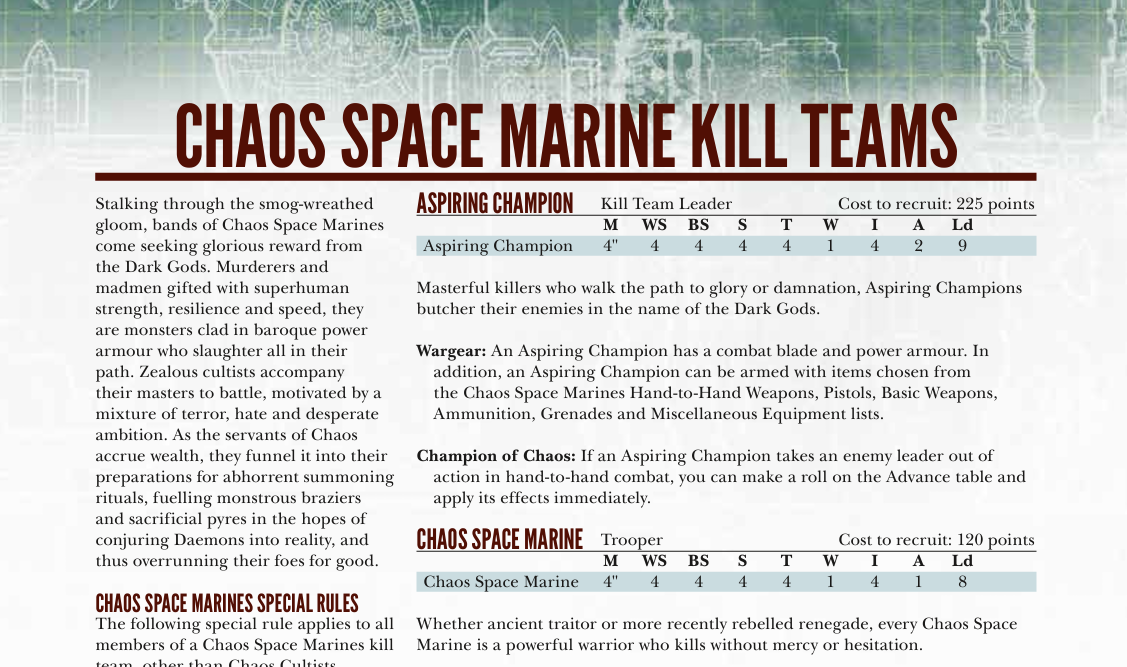
Although ostensibly marketed as a standalone game, Shadow War: Armageddon was really a vehicle for Games Workshop to sell its newest terrain kit. But it was a really good kit and that combined with a heavy dose of nostalgia would lead people to clamor for more rules and coverage for every faction in the game. Games Workshop would release a standalone print version of the book and a compendium of other teams, then go on to release digital downloads with those teams, plus FAQs, errata, and custom scenarios for “one man army” units, in which an entire team takes on a single, lone operative, armed to the teeth.
Shadow War: Armageddon was a mess in all the ways Necromunda was, and absolutely unbalanced when it came to the Compendium teams – Harlequins in particular were insane – but it was an absolute blast to play. The campaign worked well, and while the Necromunda fiction of bringing in new recruits and upgrading them to full squad members didn’t work so much for the 40k narrative, the actual process felt pretty good.
Why This Isn’t Fourth Edition
Well, for starters, it’s not officially called Kill Team, even if it uses Kill Teams. Another reason is that this release was bookended between two other editions of the game – the expansion box released in seventh edition Warhammer 40,000 and the more standalone game released a year later in 2018. That said, the popularity of Heralds of Ruin’s version of Kill Team, Necromunda in 2017, and Shadow War Armageddon clearly convinced someone at Games Workshop that Kill Team was worth having its own standalone release, and that’s what we got one year later.
Kill Team (2018)
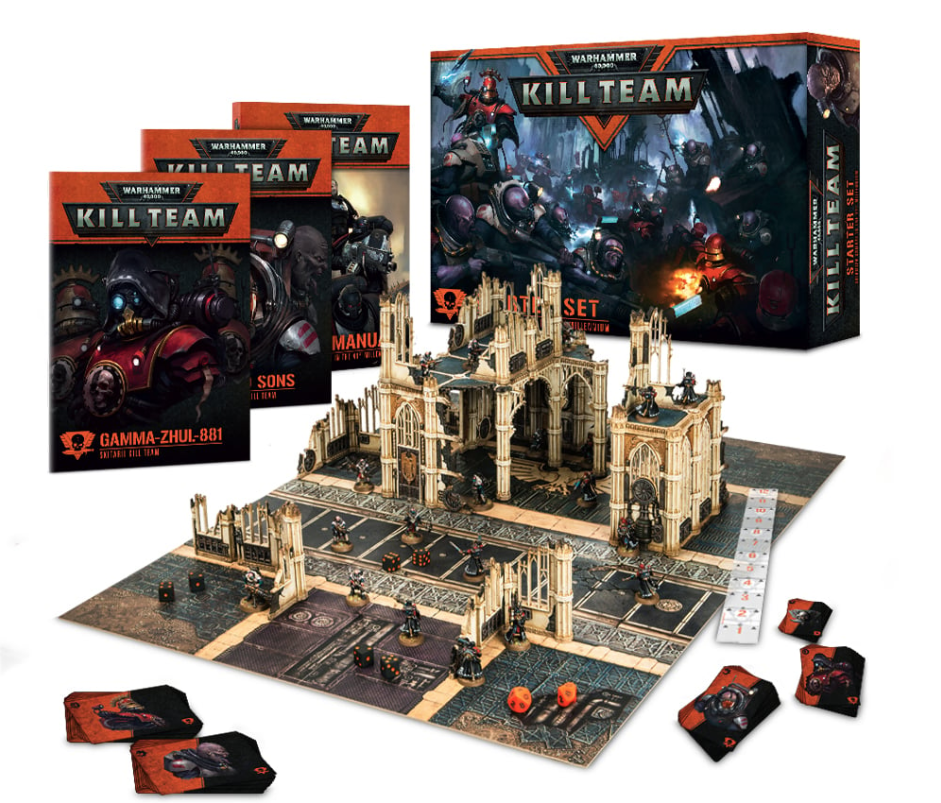
Released one year after Warhammer 40,000’s eighth edition, the 2018 edition of Kill Team is the first time the game received a true standalone release, with a boxed set, models, new rulebooks, a new board size, and custom branding. This version of Kill Team had all-new rules, and while they were very similar to eighth edition Warhammer 40k, there were also a number of differences. In many ways the rules here feel like a cross between eighth edition and Necromunda/Shadow War – vehicles are gone and teams are now bought via single models instead of as whole squads. Players build teams of 100 points from a list of operatives and wargear. You still had specialists with related skills, and the game revolved around an injury mechanic, where operatives could continue to stand back up after taking several deadly wounds.
Perhaps the most massive change was splitting turns – Kill Team games were no longer structured like 40k games, but instead took place over four battle rounds, with players alternating activations of their models in each phase. This was a big change over the traditional “I go, you go” flow of Warhammer 40k, and this phase-based alternating activations model would act as the transitionary phase for Kill Team before going to full alternating activations in 2021. The game also incorporated Command Points and Stratagems from 8th edition Warhammer 40k, putting an emphasis on resource management to pull off big plays.
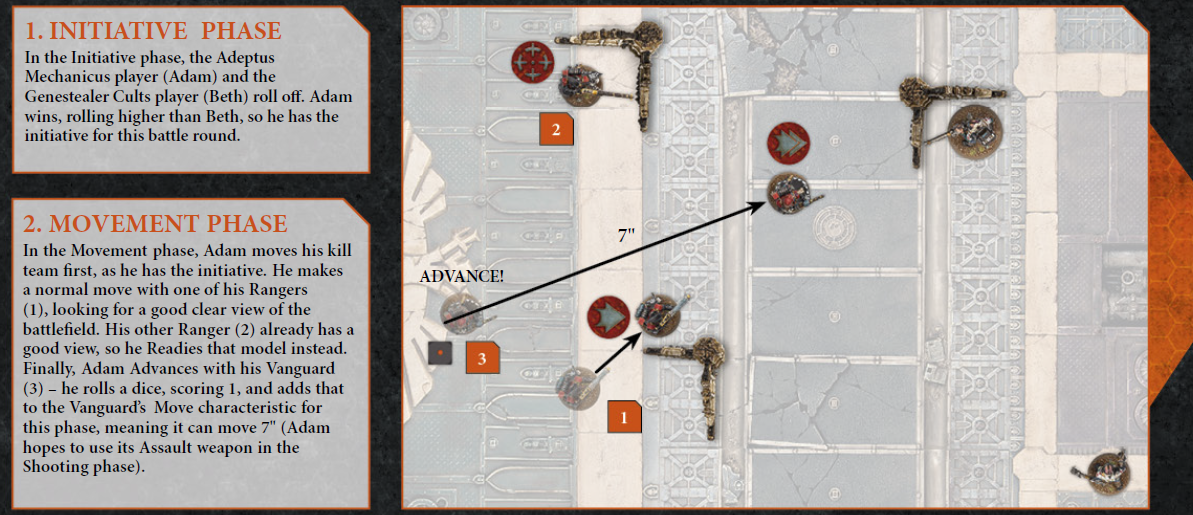
Specialists returned as well, and if you played the game’s campaign mode they’d now have more than just a single skill – every Specialism had a tree with seven skills to choose from as characters gained XP and leveled up. Later expansions would add more specialist options and trees to choose from.
It’s worth mentioning the box itself. Although the teams were older models (Adeptus Mechanicus Rangers and Genestealer Cultists), the box also included a ton of the then-brand new Sector Imperialis terrain, a set of all new, modular ruined buildings which looked fantastic and set a new standard for both the quality and size of Games Workshop terrain – 5″ floors were now a staple, replacing the 3″ floors seen in the previous Cities of Death terrain kits. These were paired with a new 22″x30″ board size, also included with the box.
While Kill Team (2018) was the best way to play squad-sized 40k to-date, it still had a large share of warts. For one, the injury mechanic was pretty bad; it was something the game needed to manage the small number of wounds per operative, but could lead to games where no operatives died, and often made it feel like you weren’t accomplishing anything. And the game’s campaign mechanics are some of the worst-conceived I’ve seen in a game, actively encouraging you not to play in order to avoid losing resources.
Kill Team (2018) would see a massive number of releases over the following four years, with a mix of proper expansions – Commanders (2018) would add multi-wound leaders to the game and increase the points total of lists to 200 while Elites (2019) would add heavier, elite units such as Terminators. Arena (2019) added a new, close confines way to play with symmetrical layouts, providing more of a competitive play framework for the game. And between 2018 and 2021 Kill Team would see nearly three dozen add-on releases, mostly in the form of Team boxes or kill zones packing terrain and custom rules for playing in a specific kill zone, such as a death world forest or a Necron tomb. The game’s final release was in March 2020 – Kill Team: Pariah Nexus introduced new models for Necron Immortals, Assault Intercessors, and rules for playing Arena games in a Necron tomb complex.

These releases were a mixed bag. The general consensus is that Elites was OK but Commanders was bad, and jokes would often pop up about how Games Workshop was going to do a Kill Team expansion for every unit category in 40k eventually. The large number of releases almost certainly contributed to that. And those releases, while usually decent combos of units and terrain – came in some pretty big boxes, often eating up a ton of retailer shelf space.
Why This Is Fourth Edition
This is obviously a new edition of the game. Depending on who you talk to, the question is whether this is the game’s first edition, since it marks the first appearance of the new Kill Team branding and logo, and the first time the game would be treated as its own product. Kill Team 2018 came with its own 208-page Core Manual featuring rules for every team in the game. Players had a ton of options to mix and match models and wargear, creating custom kill teams from a dozen or more different 40k kits.
Kill Team was very popular despite some very rough rules and bloated releases down the line, and it created enough excitement that Games Workshop was convinced to fully separate it from mainline 40k and treat it like its own, completely separate game. Which is good, because some of Kill Team (2018)’s biggest struggles came from being tethered to Warhammer 40,000 eighth edition – having to update unit entries and datasheets to match releases for 40k was a nightmare, and being stuck with the stat lines and characteristics of 40k models was a huge hindrance on the game, particularly when it came to wound counts.
Kill Team (2021)
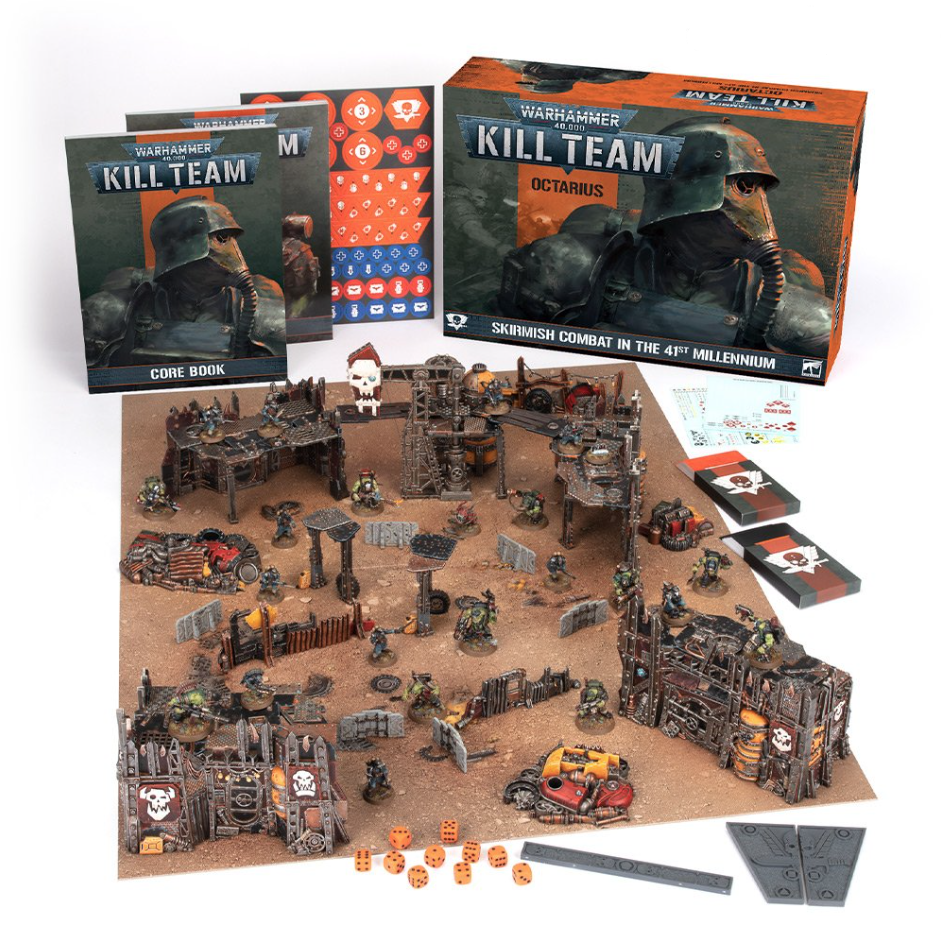
Welcome to Kill Team 2021. Released just a few months after Pariah Nexus, this is when Kill Team really became its own game. And the biggest part of this release is that for the first time, Kill Team was packaged with all-new models, created just for the game: a team of Ork Kommandos to face off against Veteran Guardsmen from the Death Korps, with new Ork-themed terrain featuring four buildings and scatter terrain (this scatter terrain was previously released in the Speed Freeks box two years prior).
Most importantly, this edition of the game was no longer tethered to 40k; while the models released would end up in 40k for obvious reasons, they had completely different stats and characteristics in Kill Team, stats much more suited to the game’s scale. For example, units no longer had a single wound – a Space Marine could have as many as 13, and most ranged weapons could just shoot across the entire table. Operatives could now receive orders to hide behind cover, allowing them to be fully concealed if they were behind terrain, regardless of the size and shape of the model. Measurement also changed, and standard measurements in inches were dropped in favor of a (poorly received) set of icons to represent specific distances, such as a triangle for 1″, a circle for 2″, and a pentagon for 6″. No, it doesn’t make any sense to us, either.
Kill Team 2021 moved to a full alternating activations model of play, with players alternating activating a single operative at a time. The game still used Command Points, adding a new system for Strategic Ploys (team effects) and Tactical Ploys (operative effects), and adopted a card-based format for missions and objective scoring. Missions took place over four turning points, and typically involved players tussling over objectives in various environments.
The other big change – and one of the more controversial changes overall – was the decision to pare back teams to be smaller in scope, with limited options. Faction-wide teams were replaced with very specific teams based around a small number of units or even a single box. Operatives tended to have only one or two options for weapons and equipment, if that. For players who enjoyed the customization of Kill Team 2018, this was a huge disappointment. For everyone else however, it made the game much more balanced and easy to start with – those options were great but they also tended to cause the price of a team to skyrocket, if you had to buy 6 or more boxes in order to assemble your team. This new method paved the way for very tight teams who could be released as a single unit or upgrade sprue. At launch the game released with a compendium for teams from every faction, but as time went on these were left by the wayside – most were replaced by other teams from the same faction, i.e. Thousand Sons were replaced with the Warpcoven Team – but some never saw updates.
Campaigns in Kill Team 2021 were run using a separate game mode referred to as Spec Ops – in this mode teams gain additional wargear and skills while upgrading their base of operations. It’s a fine mode but not particularly popular, in part because Kill Team as a game is already pretty narrative in ways that larger games are not.
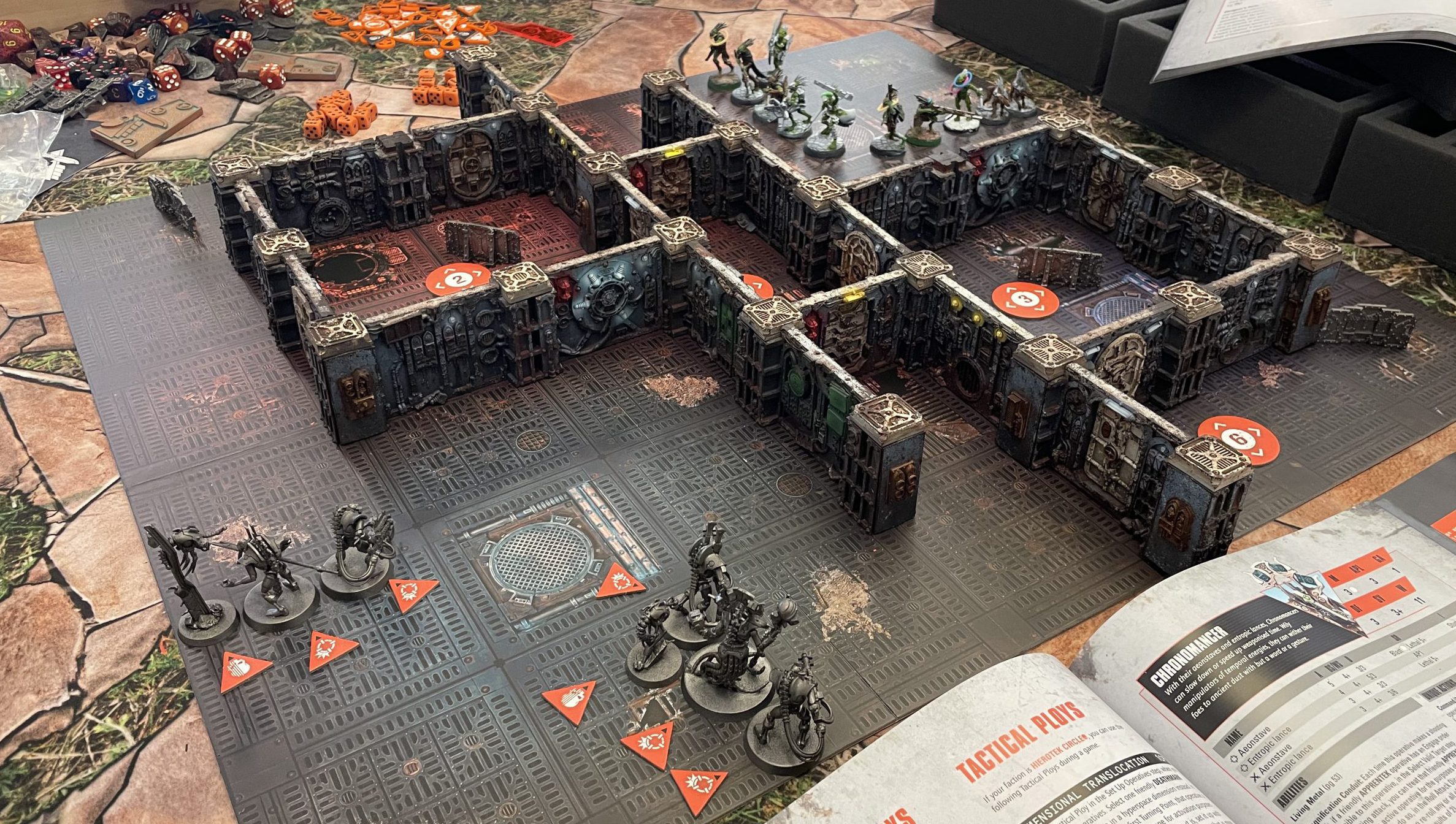
Kill Team 2021 would receive a number of updates, almost all of which came in the form of boxed sets offering two opposing teams. These were typically bundled with terrain and part of a specific season. In that regard, Kill Team 2021 had three “Seasons”:
- Octarius, featuring the Ork terrain in the starter box and generally representing “3D Kill Team.” Although boxes like Chalnath, Nachmund, and Moroch would release afterwards with different terrain, their terrain rules are fundamentally the same, just with different features.
- Gallowdark, which played out over four boxed sets (Into the Dark, Shadowvaults, Soulshackle, and Gallowfall), introduced an all new set of terrain – modular walls and hatches for games designed to take place in the cramped confines of a space hulk. Later sets would add more terrain bits and pieces to this.
- Bheta-Decima, which featured terrain for an offshore mining/drilling platform and was featured in Salvation, Nightmare, and Termination.
Of these, the Octarius format is more or less the default while Into the Dark became immensely popular, in part because of Games Workshop’s decision to send tournament organizers a set of the terrain if they’d agree to run a Kill Team event. Bheta-Decima on the other hand never really saw adoption, in part because the set lacked strong cover and line-of-sight-blocking features and in part because it sold out very quickly and no one could get their hands on a copy, let alone multiple for running an event.
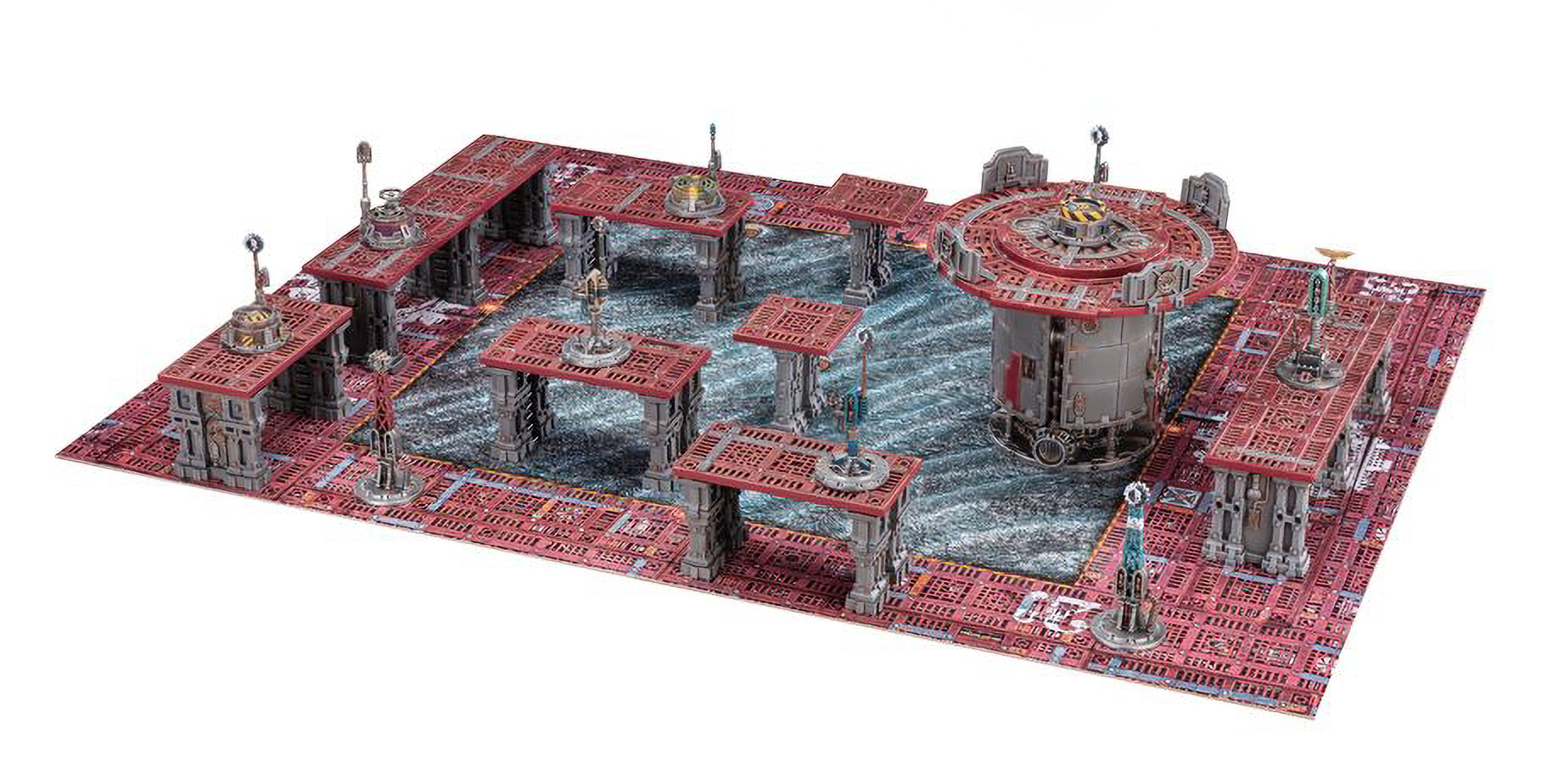
Kill Team 2021 would go on to easily become Games Workshop’s third most popular game, and in the United States it’s not uncommon for Kill Team tournaments to draw more players than Age of Sigmar, even at Games Workshop’s own US Open series events.
Why This Is Fifth Edition
This is obviously a full edition of the game. There’s some question as to whether it’s fifth edition or, as I suspect some folks internally at Games Workshop might think of it, the first edition of Kill Team as a fully standalone game, but I’m of the mind that this is the fifth full edition release we’ve seen of the game. That said, no one was calling it fifth edition when it came out – it was just “Kill Team,” as was the 2018 release before it. So we took to calling that one Kill Team ’18 and this became Kill Team ’21, or just “Kill Team.” It wasn’t that complicated. At least, not until this most recent announcement.
Kill Team (2024)
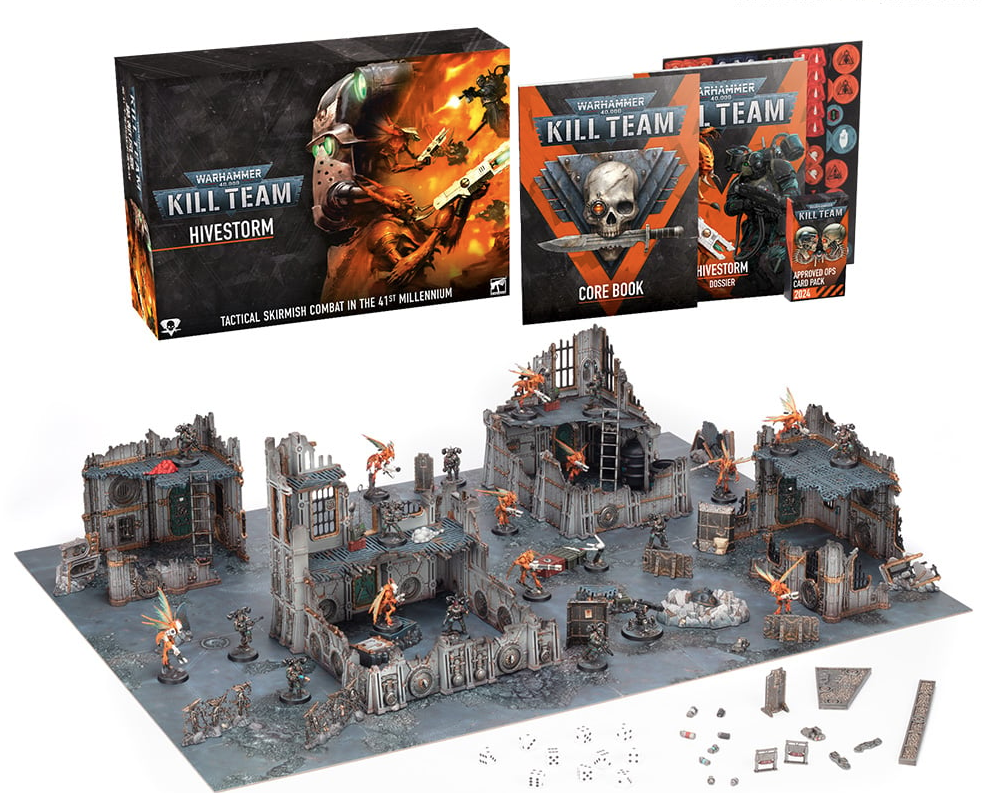
Which brings us to present day. As we await the release of Kill Team: Hivestorm to usher in a new edition of Kill Team, we’re left to speculate on what comes next. Based on everything we’ve seen so far, this looks to be an updated edition for Kill Team 2021, with streamlined stats and rules for equipment, cover, and mission rules. The box comes with a new urban combat terrain set – Volkus – which will fit right in with the 3D format.
There have been plenty of other changes, naturally – more than enough to justify a new edition. Measurement icons are gone – the game has gone back to using inches for measurement, albeit with custom measurement tools like before. Some stats have been removed – Group Activations and Defense Dice have now been streamlined, and aren’t part of an operative’s datacard. And there’s a ton of new universal equipment for players to take besides the standard barricades of last edition – players can make use of ladders, barbed wire, smoke grenades, and other nasty tricks to take down enemy teams.
The biggest news so far with this new release is an updated focus on how team releases will be handled – in Kill Team 2021, we ended up with 34 released teams across every box and Annual, and that’s not counting the original set of teams released in the Compendium shortly after launch. Moving forward, teams will receive a four-year lifespan for official competitive play (though they may receive rules support for longer), with older teams rotating out. This allows Games Workshop to keep releasing new teams without having to balance literal dozens of older teams, and creates opportunities to keep things fresh with new releases.
So What Edition Are We On?
Well, based on all of this, you have a few options. If we go back to the game’s first official release as a 40k game mode in fourth edition, we’re currently in the sixth edition of Warhammer 40k. But while that’s accurate in one very technical sense, it also doesn’t feel quite right for something that wasn’t a standalone game until 2018. We could call it third edition – many communities have already taken to calling it Kill Team 3.0 as a reference to this being the third game in that series. I’ve heard some folks referring to Kill Team 2024 as second edition, as a nod to how different this edition and 2021 were from even the 2018 release. And of course, we could always just call it Kill Team ’24, which is what we’ve been doing around the Goonhammer Offices.
But just so we’re clear, this is the sixth edition of Kill Team.
Have any questions or feedback? Drop us a note in the comments below or email us at contact@goonhammer.com. Want articles like this linked in your inbox every Monday morning? Sign up for our newsletter. And don’t forget that you can support us on Patreon for backer rewards like early video content, Administratum access, an ad-free experience on our website and more.
